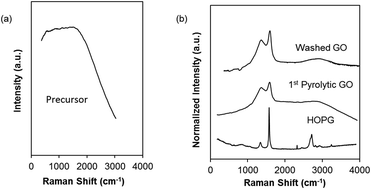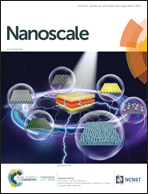Solvothermal synthesis of graphene oxide and its composites with poly(ε-caprolactone)
Abstract
Graphene oxide (GO) was prepared by a solvothermal synthesis method using sodium and ethanol. A sequence of pyrolysis, washing and purification steps was developed for the total removal of all by-products. The first pyrolysis step is essential to obtain graphitic forms of carbon while a washing and a second pyrolysis step further improved the graphenic structures obtained via the reduction of OH/COOH and C–O groups and the attendant increase in C![[double bond, length as m-dash]](https://www.rsc.org/images/entities/char_e001.gif) C bonding (sp2 hybridization). Two purification processes were employed to remove sodium carbonate (by-product), i.e. vacuum filtration and centrifugation, but the latter produced a more stable GO product, typically with a few-layer (ca. 3 nm) stack and relatively long platelets (up to ca. 1.3 μm). The functionality of this GO was demonstrated by preparing composites of it with poly(ε-caprolactone) (PCL). Some of the GO was arranged in flower-like domains dispersed in the PCL matrix. The crystalline content of PCL decreased on addition of GO, though the dynamic modulus of PCL increased and an electrical percolation at 0.5 vol% GO was obtained, manifest by a ∼104 increase in electrical conductivity (in an overall increase of ∼105 achieved at >1 vol%), more than sufficient for anti-static applications.
C bonding (sp2 hybridization). Two purification processes were employed to remove sodium carbonate (by-product), i.e. vacuum filtration and centrifugation, but the latter produced a more stable GO product, typically with a few-layer (ca. 3 nm) stack and relatively long platelets (up to ca. 1.3 μm). The functionality of this GO was demonstrated by preparing composites of it with poly(ε-caprolactone) (PCL). Some of the GO was arranged in flower-like domains dispersed in the PCL matrix. The crystalline content of PCL decreased on addition of GO, though the dynamic modulus of PCL increased and an electrical percolation at 0.5 vol% GO was obtained, manifest by a ∼104 increase in electrical conductivity (in an overall increase of ∼105 achieved at >1 vol%), more than sufficient for anti-static applications.



 Please wait while we load your content...
Please wait while we load your content...